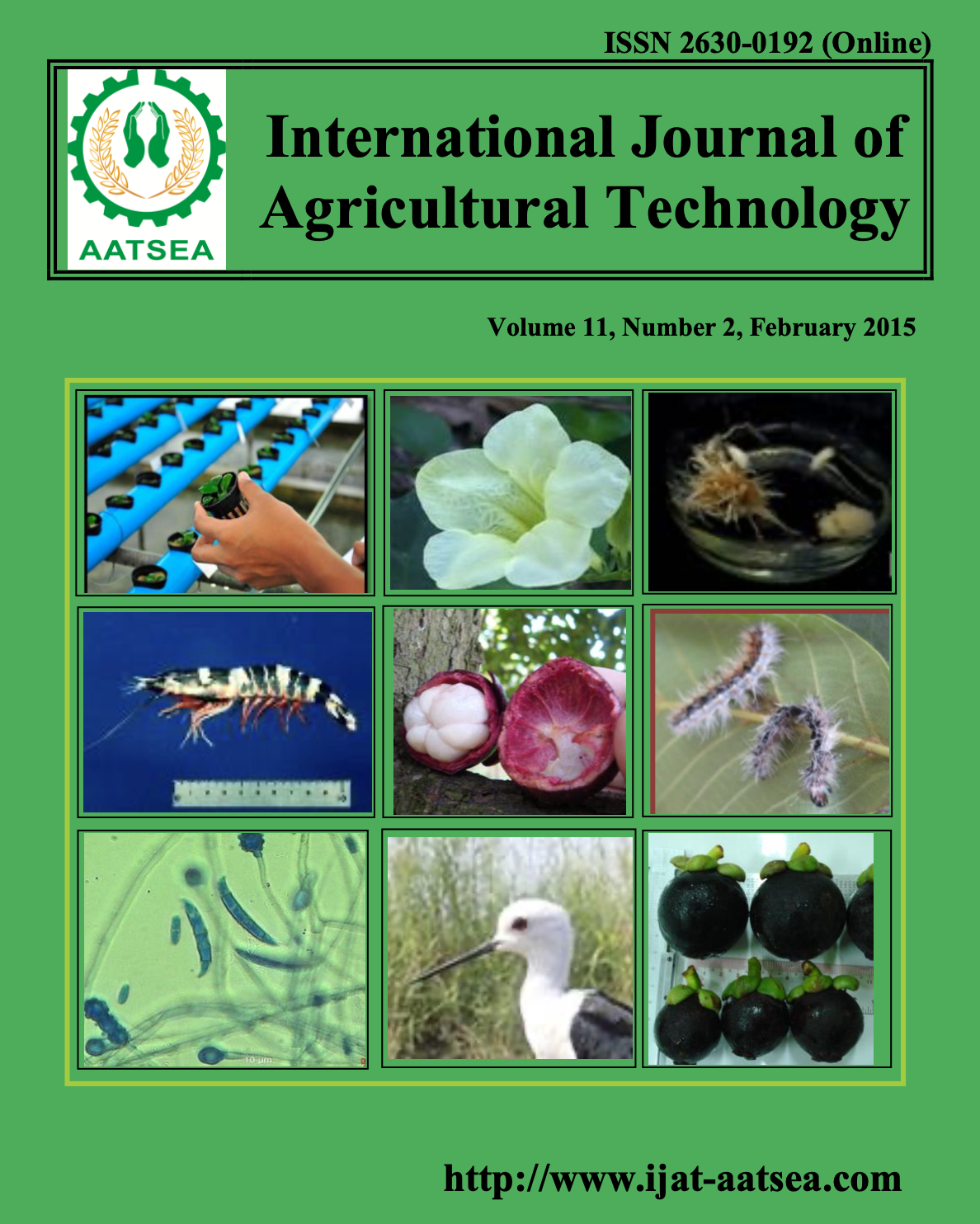Species composition and abundance of penaeid shrips in the outer Songkhla Lake of Thailand
Main Article Content
Abstract
Twenty-two species from 6 genera of Penaeidae were reported from the present study. Six species of Penaeus (Farbricius, 1798) were found; P. japonicus (Bate, 1888), P. latisulcatus (Kishinouye, 1896), P. monodon (Fabricius, 1798), P. semisulcatus (De Haan, 1844), P. merguiensis(De Man, 1888) and P. silasi (Muthu and Motoh, 1979). There were two speciesof the genus Metapenaeopsis (Bonvier, 1909); M. stridulans (Alcock, 1905) and Metapenaeopsisbarbata (De Haan, 1844). The only species in genus Solenocera (H. Milne Edwards, 1837) was Solenocera crassicornis (H. Milne Edwards, 1837). There were 7 species of Metapenaeus(Wood-Masen, Alcock, 1891); M. lysianassa(De Man, 1888), M. intermedius (Kishinouye, 1900), M. ensis (De Haan, 1844), M. affinis (H. Milne Edwards, 1837 ), M. moyebi (Kishinouye, 1896), M. brevicornis (H. Milne Edwards, 1837) and M. tenuipes (Kubo, 1949). There were 3 species of Parapenaeopsis (Alcock, 1901); P. hungerfordii(Alcock, 1905) P. hardwickii (Meirs, 1878) P. sculptilis (Heller, 1862) The genus Trachypenaeus (Alcock,1901) were found 3 species. There were 3 species of Trachypenaeus (Alcock, 1901); T. sedili (Hall, 1961), T. malaiana (Balss, 1933) and T. pescadoreensis (Schmitt,1931). The species composition of Penaeid shrimps were divided three seasons; rainy season, summer season and interseason. The most dominant Penaeid shrimps species were M. moyebi, M. ensis, P. silasi and P. merguiensisthroughout the entire study period. In general, Penaeus spp. and Metapenaeus spp. were the most abundant species found in the Outer Songkhla Lake and season. Shrimp juveniles move out from the Songkhla Lake into the Gulf of Thailand. The species composition and population abundance in this study is a fundamental development of a management policy for modeling of a shrimp population in Outer Songkhla Lake.
Article Details

This work is licensed under a Creative Commons Attribution-NonCommercial-NoDerivatives 4.0 International License.
References
Bindu, R. P. and Diwan, A. D. (2002). Effects of acute salinity stress on oxygen consumption and ammonia excretion rate of the marine shrimp Metapenaeus monoceros. Journal of Crustacean Biology 22:45-52.
Cooper, J. A. G., Wright, C. I. and Mason, T. R. (1999). Geomorphology and sedimentology. In. Allanson, B. R.and Baird D., (Eds.), Estuaries of South Africa. Cambridge: Cambridge University Press.
Dall, W., Hill, B. J., Rothlisberg, P. C. and Staples, D. J. (1990). The Biology of the Penaeidae. In: Blaxter J. H. S. and Southward A. J. (Eds.), Advances in Marine Biology 27:1-489.
Day, J. H. (1951). The ecology of South African estuaries. Part I. A review of estuarine conditions in general. Transactions of the Royal Society of South Africa 23:53-91.
Day, J. H. (1964). The origin and distribution of estuarine animals inSouth Africa. In Davis, D. H. S. (Ed.), Ecological studies in southern Africa. The Hague: W. Junk. pp.159-173.
Day, J. H. (1967). The biology of Knysna Estuary, South Africa. In Lauf, G. H. (Ed.), Estuaries. Washington, DC.
Freitas, A. J. (1986). Selection of nursery areas by six Southeast African Penaeidae. Estuarine, Coastal and Shelf Science 23:901-908.
Holthuis, L. B. (1980). FAO species catalogue. Vol. 1 Shrimps and prawns of the world. FAO Fisheries Synop 125:1-271.
Garcia, S. and Le Reste, L. (1981). Life cycles, dynamics, exploitation and management of coastal penaeid shrimp stocks. FAO Fisheries Technical Paper. pp. 203.
Garcia, S. (1984). A note on environmental aspects of penaeid shrimp biology and dynamics. In: Gulland, J. A. and Rothschild, B. J. (Eds.), Penaeid Shrimps Their Biology and Management. Farnham, UK: Fishing News Books Ltd.
Garcia, S. (1985). Reproduction, Stock Assessment Models and Population Parameters in Exploited Penaeid Shrimp Populations, In: P.C. Rothlisberg and H.P. Staples (Eds.), Second Australian National Prawn Seminar, Cleveland, Australia. pp. 139-158.
Jayakody, D. S. and Costa, H. H. (1988). Population dynamics of Indian shrimp (Penaeus indicus, Milne Edwards) on the west coast of Sri Lanka. Asian Fisheries Science 1:135-146.
Joubert, L. S. and Davies, D. H. (1966). The Penaeid Prawns of the St. Lucia Lake System. Investigation Report. Vol. 13. Oceanography Research Institute of South Africa, Association of Marine Biological Research. pp. 40.
King, M. (1995). Fisheries biology assessment and management. Blackwell Science Ltd. (Fishing News Books), Osney Mead, Oxford.
McLusky, D. S. and Elliott, M. (2004). The estuarine ecosystem: ecology, threats and management. Oxford: Oxford University Press.
Myers, R. A. and Worm, B. (2003). Rapid worldwide depletion of predatory fish communities. Nature 423:280-283.
Odum, H. T. (1953). Factors controlling marine invasion into Florida fresh waters. Bulletin of Marine Science 3:134-156.
Pauly, D. (2002). Towards sustainability in world fisheries. Nature 418:689-695.
Richmon, R. (2002). A field guide to the seashores of eastern Africa and the western Indian Ocean Islands. Second edition. Sida, Sweden and University of Dares Salaam, Tanzania. pp. 461.
Subramaniam, S. (1980). Studies on penaeid prawns with special reference to the nursery environment. (Doctor of Philosophy’s Thesis). University of Dar es Salaam.
Subramaniam, S. P. (1990). Chwaka Bay (Zanzibar, East Africa) as nursery ground for penaeid prawns. Hydrobiologia 208:111-122.
United Nations (2002). World Summit on Sustainable Development: Plan of Implementation. New York.
Worm, B., Lotze, H. K., Hillebrand, H. and Sommer, U. (2002). Consumer versus resource control of species diversity and ecosystem functioning. Nature 417:848-851.
Worm, B. and Myers, R. A. (2003). Meta-analysis of cod-shrimp interactions reveals topdown control in oceanic food webs. Ecology 84:162-173.


